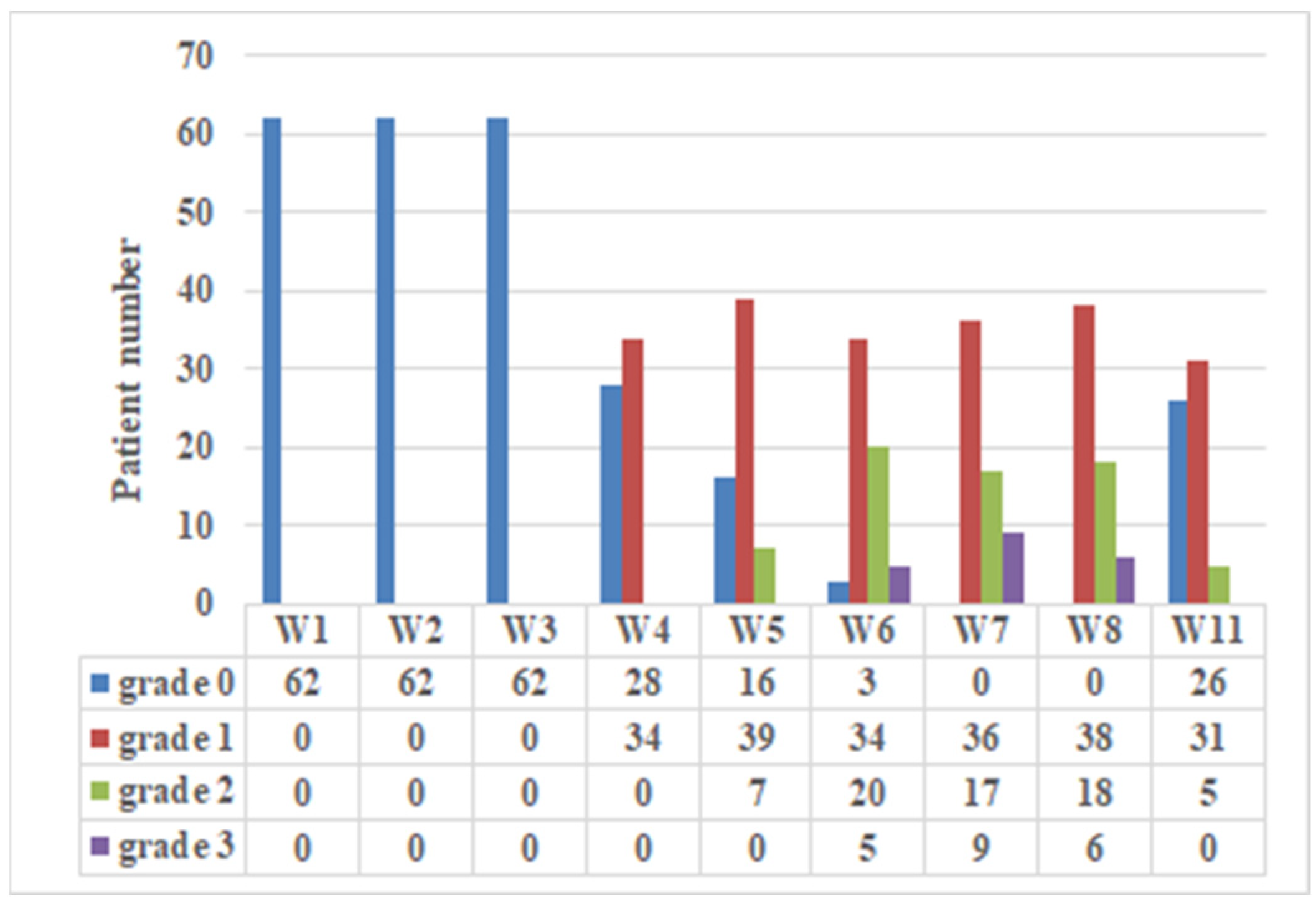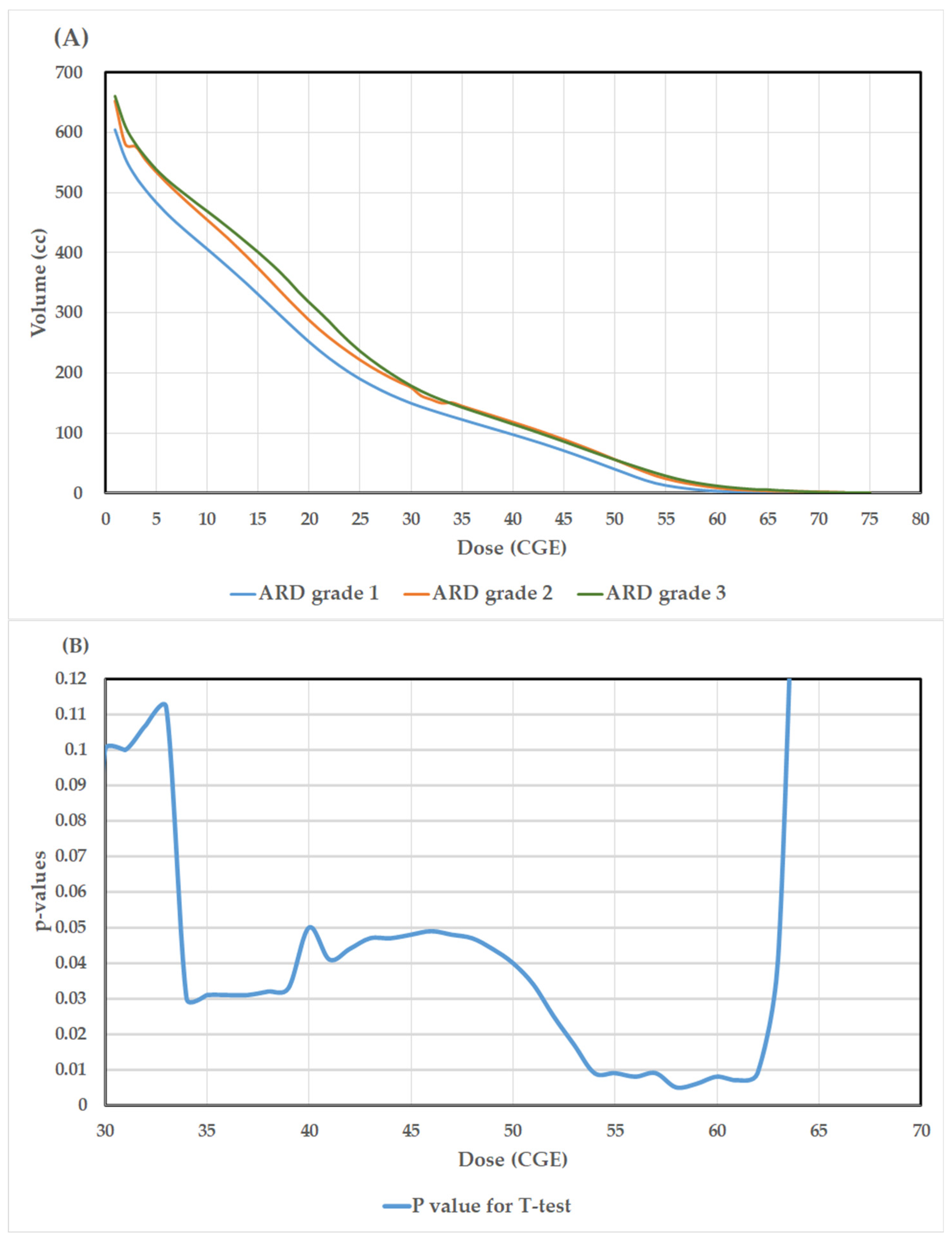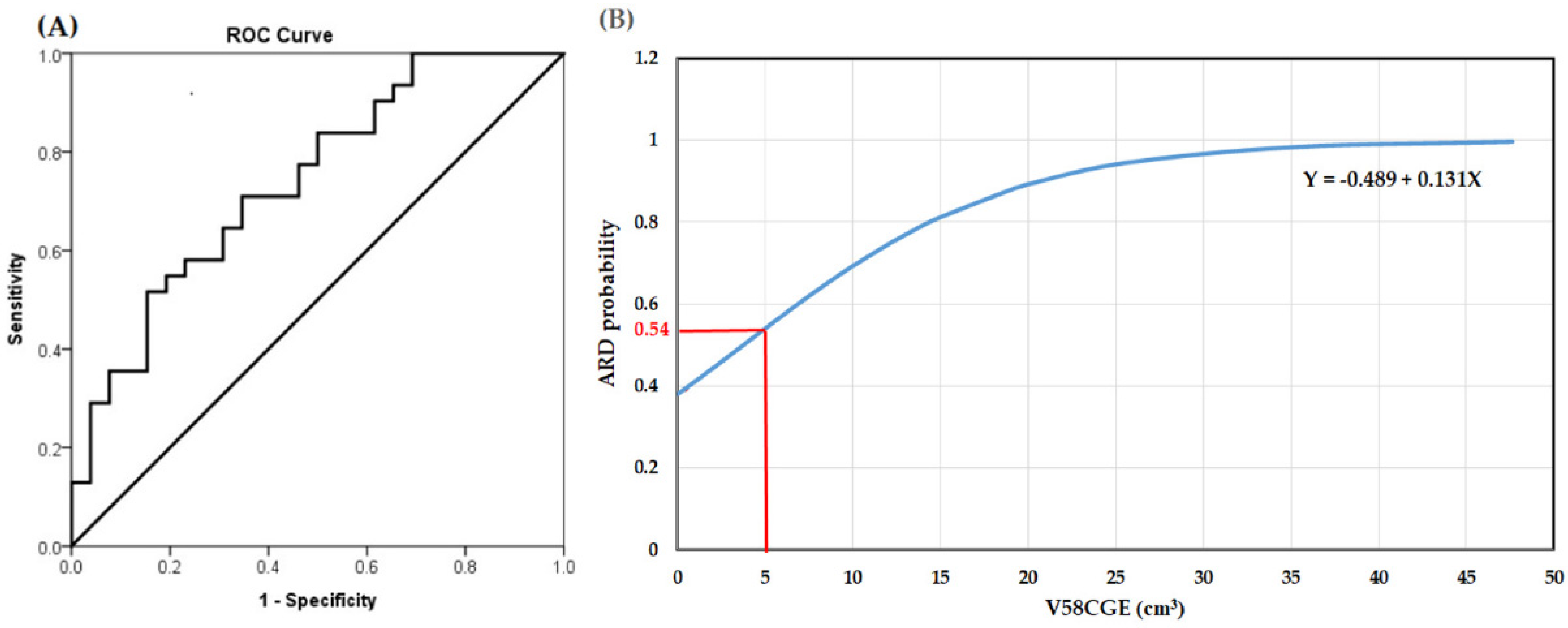Dosimetric Parameters Related to Acute Radiation Dermatitis of Patients with Nasopharyngeal Carcinoma Treated by Intensity-Modulated Proton Therapy
Abstract
:1. Introduction
2. Materials and Methods
2.1. Patient Population
2.2. Assessment of ARD
2.3. Technique of IMPT
2.4. Chemotherapy
2.5. Studied Parameters
2.6. Statistical Analysis
3. Results
3.1. Incidence and Severity of ARD
3.2. Clinical Predictor of ARD
3.3. Dosimetric Predictor of ARD
3.4. ROC Curve Analysis
4. Discussion
5. Conclusions
Author Contributions
Funding
Institutional Review Board Statement
Informed Consent Statement
Data Availability Statement
Conflicts of Interest
References
- Moreno, A.C.; Frank, S.J.; Garden, A.S.; Rosenthal, D.I.; Fuller, C.D.; Gunn, G.B.; Reddy, J.P.; Morrison, W.H.; Williamson, T.D.; Holliday, E.B.; et al. Intensity modulated proton therapy (IMPT)—The future of IMRT for head and neck cancer. Oral Oncol. 2019, 88, 66–74. [Google Scholar] [CrossRef] [PubMed]
- Chou, Y.C.; Fan, K.H.; Lin, C.Y.; Hung, T.M.; Huang, B.S.; Chang, K.P.; Kang, C.J.; Huang, S.F.; Chang, P.H.; Hsu, C.L.; et al. Intensity Modulated Proton Beam Therapy versus Volumetric Modulated Arc Therapy for Patients with Nasopharyngeal Cancer: A Propensity Score-Matched Study. Cancers 2021, 13, 3555. [Google Scholar] [CrossRef] [PubMed]
- Li, X.; Kitpanit, S.; Lee, A.; Mah, D.; Sine, K.; Sherman, E.J.; Dunn, L.A.; Michel, L.S.; Fetten, J.; Zakeri, K.; et al. Toxicity Profiles and Survival Outcomes Among Patients With Nonmetastatic Nasopharyngeal Carcinoma Treated With Intensity-Modulated Proton Therapy vs. Intensity-Modulated Radiation Therapy. JAMA Netw. Open 2021, 4, e2113205. [Google Scholar] [CrossRef] [PubMed]
- Holliday, E.B.; Frank, S.J. Proton therapy for nasopharyngeal carcinoma. Chin. Clin. Oncol. 2016, 5, 25. [Google Scholar] [CrossRef] [PubMed]
- Sherry, A.D.; Pasalic, D.; Gunn, G.B.; Fuller, C.D.; Phan, J.; Rosenthal, D.I.; Morrison, W.H.; Sturgis, E.M.; Gross, N.D.; Gillison, M.L.; et al. Proton Beam Therapy for Head and Neck Carcinoma of Unknown Primary: Toxicity and Quality of Life. Int. J. Part. Ther. 2021, 8, 234–247. [Google Scholar] [CrossRef] [PubMed]
- Holliday, E.B.; Garden, A.S.; Rosenthal, D.I.; Fuller, C.D.; Morrison, W.H.; Gunn, G.B.; Phan, J.; Beadle, B.M.; Zhu, X.R.; Zhang, X.; et al. Proton Therapy Reduces Treatment-Related Toxicities for Patients with Nasopharyngeal Cancer: A Case-Match Control Study of Intensity-Modulated Proton Therapy and Intensity-Modulated Photon Therapy. Int. J. Part. Ther. 2015, 2, 19–28. [Google Scholar] [CrossRef] [Green Version]
- Leeman, J.E.; Romesser, P.B.; Zhou, Y.; McBride, S.; Riaz, N.; Sherman, E.; Cohen, M.A.; Cahlon, O.; Lee, N. Proton therapy for head and neck cancer: Expanding the therapeutic window. Lancet Oncol. 2017, 18, e254–e265. [Google Scholar] [CrossRef]
- Williams, V.M.; Parvathaneni, U.; Laramore, G.E.; Aljabab, S.; Wong, T.P.; Liao, J.J. Intensity-Modulated Proton Therapy for Nasopharynx Cancer: 2-year Outcomes from a Single Institution. Int. J. Part. Ther. 2021, 8, 28–40. [Google Scholar] [CrossRef]
- Singh, M.; Alavi, A.; Wong, R.; Akita, S. Radiodermatitis: A Review of Our Current Understanding. Am. J. Clin. Dermatol. 2016, 17, 277–292. [Google Scholar] [CrossRef]
- Feight, D.; Baney, T.; Bruce, S.; McQuestion, M. Putting evidence into practice. Clin. J. Oncol. Nurs. 2011, 15, 481–492. [Google Scholar] [CrossRef]
- Rzepecki, A.; Birnbaum, M.; Ohri, N.; Daily, J.; Fox, J.; Bodner, W.; Kabarriti, R.; Garg, M.; Mehta, K.; Kalnicki, S.; et al. Characterizing the effects of radiation dermatitis on quality of life: A prospective survey-based study. J. Am. Acad. Dermatol. 2022, 86, 161–163. [Google Scholar] [CrossRef] [PubMed]
- Lee, N.; Chuang, C.; Quivey, J.M.; Phillips, T.L.; Akazawa, P.; Verhey, L.J.; Xia, P. Skin toxicity due to intensity-modulated radiotherapy for head-and-neck carcinoma. Int. J. Radiat. Oncol. Biol. Phys. 2002, 53, 630–637. [Google Scholar] [CrossRef]
- Emami, B.; Lyman, J.; Brown, A.; Coia, L.; Goitein, M.; Munzenrider, J.E.; Shank, B.; Solin, L.J.; Wesson, M. Tolerance of normal tissue to therapeutic irradiation. Int. J. Radiat. Oncol. Biol. Phys. 1991, 21, 109–122. [Google Scholar] [CrossRef]
- DeCesaris, C.M.; Rice, S.R.; Bentzen, S.M.; Jatczak, J.; Mishra, M.V.; Nichols, E.M. Quantification of Acute Skin Toxicities in Patients With Breast Cancer Undergoing Adjuvant Proton versus Photon Radiation Therapy: A Single Institutional Experience. Int. J. Radiat. Oncol. Biol. Phys. 2019, 104, 1084–1090. [Google Scholar] [CrossRef] [PubMed]
- Gaito, S.; Abravan, A.; Richardson, J.; Lowe, M.; Indelicato, D.J.; Burnet, N.; Smith, E. Skin Toxicity Profile of Photon Radiotherapy versus Proton Beam Therapy in Paediatric and Young Adult Patients with Sarcomas. Clin. Oncol. R Coll. Radiol. 2021, 33, 507–516. [Google Scholar] [CrossRef] [PubMed]
- Liang, X.; Bradley, J.A.; Zheng, D.; Rutenberg, M.; Yeung, D.; Mendenhall, N.; Li, Z. Prognostic factors of radiation dermatitis following passive-scattering proton therapy for breast cancer. Radiat. Oncol. 2018, 13, 72. [Google Scholar] [CrossRef] [PubMed]
- Lin, Y.H.; Cheng, J.Y.; Huang, B.S.; Luo, S.D.; Lin, W.C.; Chou, S.Y.; Juang, P.J.; Li, S.H.; Huang, E.Y.; Wang, Y.M. Significant Reduction in Vertebral Artery Dose by Intensity Modulated Proton Therapy: A Pilot Study for Nasopharyngeal Carcinoma. J. Pers. Med. 2021, 11, 822. [Google Scholar] [CrossRef]
- Lee, N.; Harris, J.; Garden, A.S.; Straube, W.; Glisson, B.; Xia, P.; Bosch, W.; Morrison, W.H.; Quivey, J.; Thorstad, W.; et al. Intensity-modulated radiation therapy with or without chemotherapy for nasopharyngeal carcinoma: Radiation therapy oncology group phase II trial 0225. J. Clin. Oncol. 2009, 27, 3684–3690. [Google Scholar] [CrossRef] [Green Version]
- Zhang, Y.; Chen, L.; Hu, G.Q.; Zhang, N.; Zhu, X.D.; Yang, K.Y.; Jin, F.; Shi, M.; Chen, Y.P.; Hu, W.H.; et al. Gemcitabine and Cisplatin Induction Chemotherapy in Nasopharyngeal Carcinoma. N. Engl. J. Med. 2019, 381, 1124–1135. [Google Scholar] [CrossRef]
- Sini, C.; Noris Chiorda, B.; Gabriele, P.; Sanguineti, G.; Morlino, S.; Badenchini, F.; Cante, D.; Carillo, V.; Gaetano, M.; Giandini, T.; et al. Patient-reported intestinal toxicity from whole pelvis intensity-modulated radiotherapy: First quantification of bowel dose-volume effects. Radiother. Oncol. 2017, 124, 296–301. [Google Scholar] [CrossRef]
- Mori, M.; Cattaneo, G.M.; Dell’Oca, I.; Foti, S.; Calandrino, R.; Di Muzio, N.G.; Fiorino, C. Skin DVHs predict cutaneous toxicity in Head and Neck Cancer patients treated with Tomotherapy. Phys. Med. 2019, 59, 133–141. [Google Scholar] [CrossRef] [PubMed]
- Dutz, A.; Lühr, A.; Agolli, L.; Troost, E.G.C.; Krause, M.; Baumann, M.; Vermeren, X.; Geismar, D.; Schapira, E.F.; Bussière, M.; et al. Development and validation of NTCP models for acute side-effects resulting from proton beam therapy of brain tumours. Radiother. Oncol. 2019, 130, 164–171. [Google Scholar] [CrossRef] [PubMed] [Green Version]
- Chugh, R.; Bisht, Y.S.; Nautiyal, V.; Jindal, R. Factors Influencing the Severity of Acute Radiation-Induced Skin and Mucosal Toxicity in Head and Neck Cancer. Cureus 2021, 13, e18147. [Google Scholar] [CrossRef]
- Isomura, M.; Oya, N.; Tachiiri, S.; Kaneyasu, Y.; Nishimura, Y.; Akimoto, T.; Hareyama, M.; Sugita, T.; Mitsuhashi, N.; Yamashita, T.; et al. IL12RB2 and ABCA1 genes are associated with susceptibility to radiation dermatitis. Clin. Cancer Res. 2008, 14, 6683–6689. [Google Scholar] [CrossRef] [PubMed] [Green Version]
- Yao, Z.; Cheng, B. Morbidity in Patients with Nasopharyngeal Carcinoma and Radiation-Induced Skin Lesions: Cause, Risk Factors, and Dermatitis Evolution and Severity. Adv. Skin Wound Care 2021, 34, 1–8. [Google Scholar] [CrossRef] [PubMed]
- Xie, Y.; Wang, Q.; Hu, T.; Chen, R.; Wang, J.; Chang, H.; Cheng, J. Risk Factors Related to Acute Radiation Dermatitis in Breast Cancer Patients After Radiotherapy: A Systematic Review and Meta-Analysis. Front. Oncol. 2021, 11, 738851. [Google Scholar] [CrossRef] [PubMed]
- Meyer, F.; Fortin, A.; Wang, C.S.; Liu, G.; Bairati, I. Predictors of severe acute and late toxicities in patients with localized head-and-neck cancer treated with radiation therapy. Int. J. Radiat. Oncol. Biol. Phys. 2012, 82, 1454–1462. [Google Scholar] [CrossRef]
- McDaniel, J.C.; Browning, K.K. Smoking, chronic wound healing, and implications for evidence-based practice. J. Wound Ostomy Cont. Nurs. 2014, 41, 415–423. [Google Scholar] [CrossRef] [Green Version]
- Morecraft, R.; Blair, W.F.; Brown, T.D.; Gable, R.H. Acute effects of smoking on digital artery blood flow in humans. J. Hand Surg. Am. 1994, 19, 1–7. [Google Scholar] [CrossRef]
- Guo, S.; Dipietro, L.A. Factors affecting wound healing. J. Dent. Res. 2010, 89, 219–229. [Google Scholar] [CrossRef]



| Characteristics | Value | % |
|---|---|---|
| Age, median (range), year | 48 (31–71) | |
| Gender, male/female | 45/17 | 72.6/27.4 |
| Smoking habit, yes/no | 19/43 | 30.6/69.4 |
| Body mass index (kg/m2), <24.0/≥24.0 | 25/37 | 40.3/59.7 |
| Diabetes mellitus, yes/no | 6/56 | 9.7/90.3 |
| Hypertension, yes/no | 8/54 | 12.9/87.1 |
| AJCC stage, I/II/III/IVA | 4/17/25/16 | 6.5/27.4/40.3/25.8 |
| T status, T1/T2/T3/T4 | 34/9/10/9 | 54.8/14.5/16.1/14.6 |
| N status, N0/N1/N2/N3 | 9/23/21/9 | 14.5/37.1/33.9/14.5 |
| Chemotherapy, yes/no | 57/5 | 91.9/8.1 |
| Variables | Grade 1 (n = 27) | Grade 2 and 3 (n = 35) | p Value |
|---|---|---|---|
| Clinical, No (%) | |||
| Age, ≥48 years | 12 (44.4) | 18 (51.4) | 0.618 |
| Gender, male | 17 (63.0) | 28 (80.0) | 0.160 |
| Smoking habit, yes | 4 (14.8) | 15 (42.9) | 0.011 |
| Body mass index, ≥24.0 kg/m2 | 13 (48.1) | 24 (68.6) | 0.124 |
| Diabetes mellitus, yes | 2 (7.4) | 4 (11.4) | 0.689 |
| Hypertension, yes | 4 (14.8) | 4 (11.4) | 0.719 |
| AJCC stage, III-IVA | 13 (48.1) | 28 (80.0) | 0.011 |
| T status, T3-T4 | 7 (25.9) | 12 (34.3) | 0.583 |
| N status, N2-N3 | 8 (29.6) | 22 (62.9) | 0.007 |
| Chemotherapy, yes | 24 (88.9) | 33 (94.3) | 0.689 |
| Dosimetric, mean (SD) | |||
| V54CGE (cm3) | 16.3 (14.0) | 29.6 (22.8) | 0.009 |
| V56CGE (cm3) | 9.9 (9.9) | 20.4 (18.5) | 0.008 |
| V58CGE (cm3) | 5.7 (6.8) | 14.0 (14.5) | 0.005 |
| V60CGE (cm3) | 3.2 (4.7) | 9.2 (11.1) | 0.008 |
| V62CGE (cm3) | 1.9 (3.4) | 5.9 (8.8) | 0.009 |
| CTV-L (cm3) | 147.2 (44.8) | 164.1 (42.7) | 0.151 |
| CTV-M (cm3) | 187.0 (44.0) | 205.9 (71.9) | 0.249 |
| CTV-H (cm3) | 67.8 (40.5) | 107.6 (69.9) | 0.013 |
| Model | Variable | OR (95% CI) | p Value |
|---|---|---|---|
| Clinical model | Smoking habit: yes (ref. no) | 5.156 (1.438–18.493) | 0.012 |
| N status: N2-N3 (ref. N0-N1) | 4.935 (1.583–15.381) | 0.006 | |
| Dosimetric model | V58CGE, continuous | 1.139 (1.017–1.276) | 0.024 |
| Metric | Parameter | AUC | 95% CI |
|---|---|---|---|
| Single parameter | Smoking habit | 0.67 | 0.52–0.81 |
| N status | 0.69 | 0.55–0.83 | |
| V58CGE | 0.74 | 0.61–0.87 | |
| Two-parameter metric | Smoking habit + N status | 0.78 | 0.66–0.90 |
| Three-parameter metric | Smoking habit + N status + V58CGE | 0.82 | 0.72–0.93 |
Publisher’s Note: MDPI stays neutral with regard to jurisdictional claims in published maps and institutional affiliations. |
© 2022 by the authors. Licensee MDPI, Basel, Switzerland. This article is an open access article distributed under the terms and conditions of the Creative Commons Attribution (CC BY) license (https://creativecommons.org/licenses/by/4.0/).
Share and Cite
Fang, K.-C.; Huang, T.-L.; Liao, K.-C.; Lee, T.-F.; Hsieh, Y.-W.; Tsai, W.-L.; Fang, F.-M. Dosimetric Parameters Related to Acute Radiation Dermatitis of Patients with Nasopharyngeal Carcinoma Treated by Intensity-Modulated Proton Therapy. J. Pers. Med. 2022, 12, 1095. https://doi.org/10.3390/jpm12071095
Fang K-C, Huang T-L, Liao K-C, Lee T-F, Hsieh Y-W, Tsai W-L, Fang F-M. Dosimetric Parameters Related to Acute Radiation Dermatitis of Patients with Nasopharyngeal Carcinoma Treated by Intensity-Modulated Proton Therapy. Journal of Personalized Medicine. 2022; 12(7):1095. https://doi.org/10.3390/jpm12071095
Chicago/Turabian StyleFang, Ko-Chun, Tai-Lin Huang, Kuan-Cho Liao, Tsair-Fwu Lee, Yang-Wei Hsieh, Wen-Ling Tsai, and Fu-Min Fang. 2022. "Dosimetric Parameters Related to Acute Radiation Dermatitis of Patients with Nasopharyngeal Carcinoma Treated by Intensity-Modulated Proton Therapy" Journal of Personalized Medicine 12, no. 7: 1095. https://doi.org/10.3390/jpm12071095
APA StyleFang, K.-C., Huang, T.-L., Liao, K.-C., Lee, T.-F., Hsieh, Y.-W., Tsai, W.-L., & Fang, F.-M. (2022). Dosimetric Parameters Related to Acute Radiation Dermatitis of Patients with Nasopharyngeal Carcinoma Treated by Intensity-Modulated Proton Therapy. Journal of Personalized Medicine, 12(7), 1095. https://doi.org/10.3390/jpm12071095







